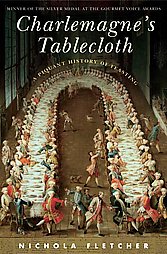Nichola Fletcher, Charlemagne's Tablecloth: A Piquant History of Feasting, London: St. Martin's Press, 2005.
Feasts, banquets, and revelrous dinners have always played a vital role in human lives. They butter the wheels of diplomacy, pave the paths of the ambitious, and spread joy at family celebrations. They lift the spirits, involve all our senses and, at times, transport us to completely phantasmagoric worlds. Nichola Fletcher has written a gripping history of feasts throughout the ages, not only about food but also the array of anthropologic rituals and cultural codes that are ensconced within the feasting occasion.
From a humble meal of potatoes provided by an angel, to the extravagance of the high medieval and Renaissance tables groaning with wild boar, to the exquisite refinement of the Japanese tea ceremony, Charlemagne’s Tablecloth covers them all. In her gustatory exploration of history’s great feasting tables, Fletcher also answers a few riddles such as “Why did Charlemagne use an asbestos tablecloth at his feasts?” and “Where did the current craze for the elegant Japanese Kaiseki meal begin? This is an eclectic collection of feasts from the flamboyant to the eccentric, the delicious to the disgusting, one personal favourite is the chapter on the most theatrically absurd amphitryon of all times: Alexandre Balthazar Laurent Grimod de La Reynière.
For anyone who has ever sat down at a banquet table and wondered, “Why?” Nichola Fletcher provides the delicious answer in a book that is a lavish feast all its own.
